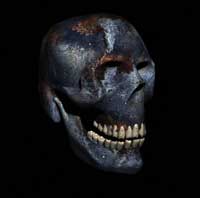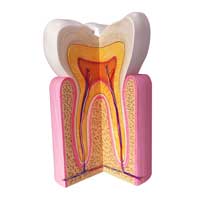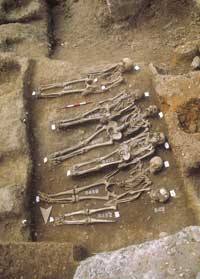Tales from a plague pit Understand article
Archeology and genetics combine to reveal what caused the Black Death.

Pooka, Wellcome images
The Black Death is without a doubt one of the most famous infectious diseases in history. Sweeping across Asia and Europe during the mid-fourteenth century, it reduced European populations by as much as 50% in urban centres, in the space of just five years (1347–1351)w1. This huge death toll had a long-lasting effect on European culture: large declines in the peasant class destabilized the feudal system, paving the way for more favourable economic systems. Soon citizens could own their own land and cultivate their own crops.
Many historical records document the path of the Black Death across medieval Europe, and some even include graphic descriptions of the disease’s gruesome symptoms. The hallmark feature of the ‘pestilence’, as it was called at the time, was the presence of a single egg-sized swelling somewhere on the body. Based on this feature, medical historians today assume the disease was an unusually aggressive outbreak of bubonic plague, caused by the bacterium Yersinia pestis. Plague is normally found in rodents, which transmit the disease to each other through flea bites. Humans are one of about 200 mammalian species that are susceptible hosts to Y. pestis infections, and under certain conditions that we don’t fully understand yet, the disease can pass from rodents to humans. Today we still see about 2000 Y. pestis infections per year in the world, but they’re nothing of the scale of the Black Deathw2.

preventative costume, people
thought the disease was
spread by foul air.
Image courtesy of Wellcome
Library, London
The question of why humans succumbed to the Black Death is still unsolved. After all, a quick stroll though a subway station of any major city will tell you that we’re not exactly free of rats. So was it that humans were living under conditions more conducive to bacterial infections in the past? Were medieval people simply more vulnerable to the disease, perhaps due to something in their genes? Or was the bacterium itself different in some special way that made it more virulent? An answer might come from the skeletons of people who were buried in plague pits in the city of London, England, during the height of the Black Death.
Digging down
Have you ever been to Tower Hill tube station in London? If so, you were right across the road from an ancient burial ground for plague victims. From 1986 to 1988, archaeologists at the Museum of London excavated this medieval plague pit and recovered the skeletons of 600 people (and there are still about 2000 more in the ground!)w3.
I am part of a research team that took teeth from these skeletons to screen them for tiny pieces of Y. pestis DNA that might have survived being buried in the soil for almost 700 years.
Teeth are the best part of the skeleton to use because the hard outer enamel works like a shell, protecting the DNA in the interior of the tooth for centuries. You can think of this combination of archaeology and molecular biology as our lens to look into the past. Thanks to scientific developments in the past few years, we can now catch tiny pieces of DNA from ancient diseases and look for clues about how their genes have changed over time. We can then use these differences to figure out how pathogens evolve.
Tooth extraction
After collecting the teeth, we take them through a chemical process to isolate the DNA molecules from the cells that we’ve recovered. Unfortunately this process indiscriminately takes DNA from all sources – plant, human, soil, bacteria – and somewhere in this giant molecular haystack are the tiny pieces of ancient pathogen DNA. The problem is finding them.

hard enamel shell of teeth
can protect DNA in the pulp
for years.
Image courtesy of iStock
We use something called DNA capture to get these specific pieces of DNA. It’s kind of like fishing, only rather than catching fish, we catch molecules. We design baits that match parts of the genetic code of the Y. pestis target we are looking for and go fishing in our giant molecular haystack, pulling out fragments that match. The whole process takes about a week, and at the end we have a raindrop-sized amount of liquid that hopefully contains pieces of the genetic code of the ancient pathogen that have survived for hundreds of years inside the tooth.
We don’t end up with one long string of DNA coding for Y. Pestis. Instead, we have a whole bunch of tiny fragments of DNA. We can then use a computer (and a computer specialist!) to put the puzzle back together, giving us the reconstructed ancient genome of the disease. But don’t worry – it’s just a file on a computer, it’s not in our lab!

Image courtesy of Museum of
London Archaeology
With the reconstructed genome on file, we can compare the ancient disease to the versions of Y. pestis that circulate today, to see if it has changed over time. Interestingly, we found that the ancient plague was almost identical to the Y. pestis bacteria that is around today, which was something we weren’t expecting.
This means that the ancient disease was probably no more virulent than the one we see today. So perhaps, rather than the disease changing, humans themselves have changed.
We could simply be living under conditions that prevent large-scale infections like the one that plagued medieval Europe, but a more intriguing possibility is that our genes may have changed to make us better able to deal with this particular infectious disease. The next step will be to look at ancient humans to see if their genes are different from ours. Clearly there are more secrets in ancient bones, and now we have the knowledge and expertise to do our detective work!
Web References
- w1 – An interactive map shows how the Black Death spread across Europe in a few short years.
- w2 – The Education Portal discusses the microbiology of Yersinia pestis, including videos and quizzes.
- w3 – You can also get more information from the Museum of London about plague in the city
Resources
- The game Plague Inc., developed in association with the Wellcome Trust, is a mix of strategy and realistic simulation available for mobiles and PCs. As a pathogen, you must continually evolve to become a global plague.
- Plague is a zoonotic infection, passed from animals to humans. You can find out more about how infectious agents can make the leap in issue 27 of Science in School.
- Heymann J (2012) Evolving threats: Investigating new zoonotic infections. Science in School 27: 12-16.
Review
This article is appropriate for learning in an interdisciplinary way. Science teachers could use this article as a basis for projects in subjects such as molecular biology, biochemistry of DNA or microbiology, and even link in elements of bioinformatics.
The article could be used with students for a discussion about the transmission, diffusion and evolution of some infectious diseases such as the Black Death. Students will understand the active research underway about the biology of Y. pestis and the extent of infections of this bacterium each year in Europe and throughout the world, and can compare this information with the history of the Black Death.
The article could also be used to start a project analysing the structure of the human tooth and how it is used for DNA extraction, as well as the techniques used to compare modern and ancient fragments of Y. pestis DNA and other bacteria with human DNA. A more intriguing activity is to ask students to hypothesise about the future of this research and, particularly, about its utility in helping us to understand changes in some of our genes.
Marina Minoli, Didactic expert at Agora University Active Science, Italy
